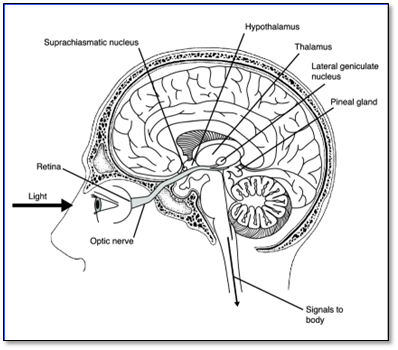Good Blue, Bad Blue?

But the characteristics of rods and cones, and a third type of receptor that was discovered almost 40 years ago, but was not included in textbooks, have another function aside from the creation of color, and that has to do with time. Rods are slow to respond to stimulus, while cones are more rapid, and by comparing those responses the brain is able to create a ‘temporal framework’ that adds to the brain’s ‘time sense’. The 3rd type of receptor cell found in the eye, known as ipRGC (Intrinsically photosensitive retinal ganglion cells, which is why they were not in the textbook…), contains a light sensitive protein but does not help the brain to form images. As that protein responds to light slowly over a longer period of time, it tells the brain about the presence of ambient light, helps the pupils to widen and narrow, and is a key resource in the formation of circadian rhythm, the body’s internal 24-hour clock, much of which is formed in the brain’s suprachiasmatic nucleus.
The display industry, in recent years, has championed the concept that blue light is dangerous, and while it is an integral component of full-color displays, it is promoted as something that should be avoided by consumers, with many brands promoting “low blue light” displays or similar seemingly ‘woke’ slogans. But whether blue light is good or bad for humans is a more complex question and one that the Circadian Light Research Center has been studying since 1983, in order to help improve the performance of 24/7 workforces for international companies.
Studies performed in the early 2000’s placed the blue onus on blue light at 460nm, known as royal blue, but while there was no question that exposure to blue light has been linked to dozens of serious health disorders, such as sleep issues, depression, obesity, diabetes, cardiovascular disease, and hormone-related cancers, as it upsets the body’s circadian rhythm, the studies were done with very short exposure periods (<90 min.), which had little to do with the realities of blue light exposure in everyday life. The Center’s research studies in recent years have indicated that under normal office working conditions the ‘blue’ that needed to be controlled to reduce health risks is at 477nm, known as sky blue. While this might seem a small difference, sky blue is almost at the peak sensitivity point of the circadian photopigment (melanopsin) in the human eye, while royal blue sensitivity is most prominent when the eye has adapted to a dark lighting situation. Further studies at Harvard confirmed the concept that while royal blue is more heavily triggered as cones become adapted to initial light sources, such as upon waking, that reaction fades over time, transitioning to sky blue sensitivity as the day progresses. The brain uses these chemical transitions to keep track of 24-hour circadian cycles.
In an ideal working environment, office lighting and displays should have plenty of blue light, across the entire blue light spectrum, but after sunset that light should have as little blue light as possible in order that the body’s circadian rhythm is maintained as it was before humans were removed from natural light environments. That said we live in a display-oriented society, with most days ending by holding a smartphone screen inches away from our eyes, which can confuse our circadian clocks by triggering ‘daylight’ responses if the blue is not eliminated. One can see how this artificial daylight causes those cycles to be interrupted, and while many believe that late-night social media is responsible for sleep disorders and the like, disrupting the body’s circadian rhythm on a regular basis has longer-term and likely longer-lasting consequences.
The most practical response to the problem would be to limit display use to daylight hours when blue-enriched displays mimic daylight, but that is not a practical one, or one that works in an office environment where hours are not dictated by sunrise and sunset. There are LED lighting systems that are designed to be ‘circadian modulated’ and shift blue light content over a 24 hour period, which are ideal for facilities that operate on a 24 hour schedule, such as hospitals or police stations, but for the average consumer the best solution is to make sure your phone has a blue light filter or download an app that provides same, many of which will allow the user to set the time when the filter Is automatically turned on. While this won’t reduce the tension associated with no one appreciating your latest Tweet, it will keep your circadian cycles intact which will have much longer-term health benefits.
If you don’t have a blue filter on your phone, here are a few free apps that can do the trick (we don’t get compensation for directing anyone to these links):
https://play.google.com/store/apps/details?id=com.urbandroid.lux&cjevent=b936ad6da24511ed83d82ea30a82b839
https://play.google.com/store/apps/details?id=com.palmerin.easyeyesfree&cjevent=06dcb0baa24611ed80ba6bb40a82b821
https://play.google.com/store/apps/details?id=com.eyefilter.nightmode.bluelightfilter&cjevent=2527ab03a24611ed81b9015a0a82b820
https://play.google.com/store/apps/details?id=jp.ne.hardyinfinity.bluelightfilter.free&cjevent=3176ecc5a24611ed83d82ea40a82b839
https://play.google.com/store/apps/details?id=com.ascendik.eyeshield&cjevent=3dea197ba24611ed817df7780a82b82c

 RSS Feed
RSS Feed